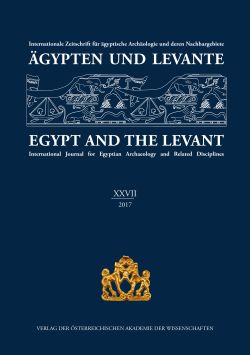Manfred Bietak
ist emer. Professor für Ägyptologie an der Uni Wien
|
 |
Inhaltsverzeichnis/Contents
Abkürzungen/Abbreviations
Manfred Bietak und Ernst Czerny, Vorwort für das Herausgebergremium/Preface for the Editorial
Board
Hanan Charaf, Jean-Paul Thalmann (1946-2017). Nécrologie
Grabungsberichte/ Excavation Reports:
Tell el-Retaba
Sławomir Rzepka, Jozef Hudec, Łukasz Jarmużek, Veronika Dubcová, Lucia Hulková, Anna
Wodzińska, and Alena Šefčáková, with an appendix by Eva Stopková, From Hyksos Tombs to
Late Period Tower Houses. Tell el-Retaba – Seasons 2015–2016
Sylwia Buławka, Flint Artefacts from Tell el-Retaba. Polish-Slovak Archaeological Mission,
Seasons 2010–2016
Alena Šefčáková, Anthropological Observations from Tell el-Retaba
Sai
Julia Budka, Pyramid Cemetery SAC5, Sai Island, Northern Sudan. An Update Based on
Fieldwork from 2015–2017
Werkstattgespräche zu Abfallhaufen und kultischen Ablagerungen
Christian Knoblauch and Vera Müller, Contributions to the Workshop “Werkstattgespräche zu
Abfallhaufen und kultischen Ablagerungen”
Teresa Bürge, Ritual Depositions versus Garbage Pits: A Re-evaluation of Pottery Deposits
and Offering Pits at the Late Bronze Age City of Hala Sultan Tekke, Cyprus
Lucia Hulková and Anna Wodzińska, Rubbish or Technology? A Short Discussion
Vera Müller, Waste, Offerings or Cultic Depositions? An Insight into the Varieties of
Depositional Practices in Ancient Egypt
Noga Ayali-Darshan, The Background of the Cedar Forest Tradition in the Egyptian Tale of the
Two Brothers in the Light of West-Asian Literature
Daphna Ben-Tor, Ramesside Scarabs Simulating Middle Bronze Age Canaanite Prototypes:
Canaanite or Egyptian?
Julia Budka and Tamás Mekis, The Family of Wah-ib-Re I (TT 414) from Thebes
Wojciech Ejsmond, The Necropolis of er-Rizeiqat
Israel Finkelstein, Dafna Langgut, Meirav Meiri and Lidar Sapir-Hen, Egyptian Imperial
Economy in Canaan: Reaction to the Climate Crisis at the End of the Late Bronze Age
Israel Finkelstein, Eran Arie, Mario A.S. Martin and Eli Piasetzky, New Evidence on the Late
Bronze/Iron I Transition at Megiddo: Implications for the End of the Egyptian Rule and the
Appearance of Philistine Pottery
Roman Gundacker,Papyrus British Museum 10056: Ergebnisse einer Neukollationierung und
Anmerkungen zur inhaltlichen Auswertung im Rahmen der militärischen Ausbildung
Amenophis’ II
Christiana E. Köhler,The Development of Social Complexity in Early Egypt. A View from the
Perspective of the Settlements and Material Culture of the Nile Valley
Massimiliano Nuzzolo and Jaromír Krejčí, Heliopolis and the Solar Cult in the Third
Millennium BC
Anna-Latifa Mourad, Asiatics and Levantine(-infuenced) Products in Nubia: Evidence from the
Middle Kingdom to the Early Second Intermediate Period
Katharina Streit,Transregional Interactions between Egypt and the Southern Levant in the 6th
Millennium calBC
Sabine Tschorn,Nun-Schalen aus der Stadt des Neuen Reiches auf der Insel Sai
|

